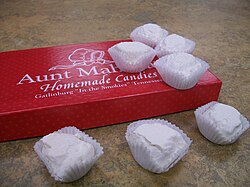History
Believed to have originated in the U.S. during the early 1900s, the candy's current form can be traced to a recipe from 1915. An earlier version, which included the use of milk, can be traced to around 1907. [1]
One proposed theory for its origins is that in the early 20th century, corn syrup (a major ingredient) became commonly used as a popular sugar substitute. New recipes incorporating corn syrup were frequently created by the major manufacturers, one of which may have been divinity. [1]
The origins of the name are not clear. The most popular theory is simply that the first person to taste it called it "divine" and the name stuck. [1]
Divinity has at times been referred to as a "Southern candy", most likely because of the frequent use of pecans in the recipe. It eventually made its way north, and today its recipe can be found in many cookbooks. [1]
This page is based on this
Wikipedia article Text is available under the
CC BY-SA 4.0 license; additional terms may apply.
Images, videos and audio are available under their respective licenses.
